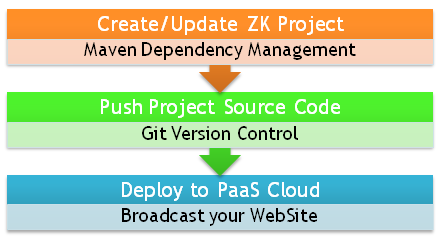ZK on PaaS Clouds: Heroku and OpenShift Express
Vincent Jian, Engineer, Potix Corporation
February 24, 2012
ZK5
PaaS Cloud
Platform as a service (PaaS[1]) is a kind of cloud computing service that provides a computing platform and a solution stack as a service. Instead of hosting and maintaining server by themselves, many companies start to take advantage of PaaS services as the offerings are extensive and includes the whole cycle of application hosting, development, testing, and deployment environment, along with a complete options of integrated services that consist of scalability, maintenance, and more. Here we will introduce how to deploy ZK applications on two popular PaaS platforms - Heroku and OpenShift Express.
Heroku
Heroku[2], owned by Salesforce.com currently supports six languages: Ruby, Java, Node.js, Scala, Clojure and Python cloud PaaS. It also provides a lot of add-ons, such as Heroku Scheduler, ClearDB MySQL Database, NoSql related database, and so on.
OpenShift Express
OpenShift[3] is a free, auto-scaling platform-as-a-service for Java, Ruby, PHP, Perl and Python applications provided by Red Hat. It also supports MySQL, MySQLi, PDO MySQL, PDO SQLite, Amazon-RDS databases, and so on.
Deploying ZK Apps to Heroku & OpenShift Express
Traditionally the "standard way" to deploy an application to a cloud, is to package a war file and then upload it to the cloud. Whenever there is a change, we will have to update the war file locally again, and then re-upload the file. Heroku and OpenShift, however, both integrated Maven and GitHub, offering the ability to remotely control source code versions. Users can build and manage their projects using Maven, and push their source code to the cloud service via GitHub and build the project on cloud automatically.
The flow chart is as simple as follows:
Even though both Heroku and OpenShift supports Maven and Git for ease of deployment and maintenance, there are some differences in the usage and supported platforms. The brief steps for running ZK on Heroku and OpenShift are as will be explained in the next section:
Heroku
- Install Ruby, Git, Heroku Gem and register for Heroku.
- Create a maven project with Jetty or Tomcat server embedded.
- Add git version control to the project.
- Deploy the whole maven project to Heroku with git push heroku master command.
For more details on running ZK on Heroku, please refer to the Installation Guide.
OpenShift Express
- Apply OpenShift account or Ret Hat Network account
- Create an OpenShift domain name
- Create a default Maven project and visit the default web pages on OpenShift.
- Modify the project after you have created the maven application.
- Push the whole modified maven project to OpenShift with git push origin master command.
For more details on running ZK on OpenShift, please refer to the Installation Guide.
The Differences
Let's see more detailed features of Heroku and OpenShift with the table below:
| Features | Heroku | OpenShift Express |
|---|---|---|
| Supporting Languages | Ruby, Java, Node.js, Scala, Clojure, Python | Java, Ruby, PHP, Perl, Python, Node.js |
| Deploy from source | Git + Maven | Git + Maven |
| Deploy from existing war | No | Yes |
| Container | Embedded Jetty or Tomcat | JBossAS 7.0 |
| Datebase | NoSql add-ons, PostgreSQL, ClearDB, ... | MySQL, PDO SQLite, MongoDB, PostgreSQL, ... |
| Sample ZK App | Yes[1][2] | Yes[3][4] |
From the table above you can find that both of them allow simple Maven + Git approach but each platform supports a different set of containers and databases.
Conclusion
The process of deploying ZK Sandbox to either Heruko and OpenShift requires little effort with a very shallow learning curve with satisfying resulting performance; I managed to complete the whole procedure in less than 1.5 hours for each platform even with my first attempt. To access ZK Sandbox deployed on Heroku and OpenShift, please visit ZK Sandbox on Heroku and ZK Sandbox on OpenShift.
Whether to use Heroku or OpenShift or a different PaaS solution depends on your needs and preferences but these options are available and surely benefits in enabling application developers to focus more on the project itself rather than worrying about deployment issues.
References
- ↑ PaaS: http://en.wikipedia.org/wiki/Platform_as_a_service
- ↑ Heroku: http://www.heroku.com/
- ↑ OpenShift Express: http://openshift.redhat.com/app/
- ↑ Simon Massey's slideshare: ZK, Spring & JPA On Two PaaS Clouds
Comments
| Copyright © Potix Corporation. This article is licensed under GNU Free Documentation License. |
